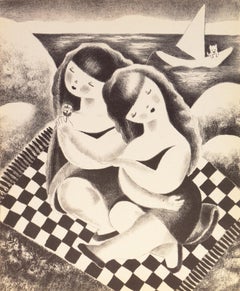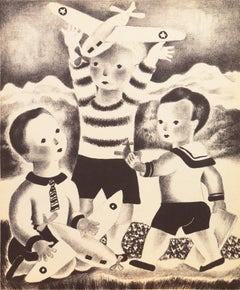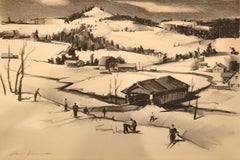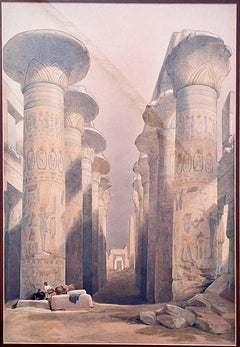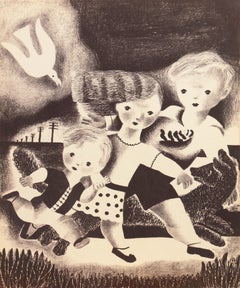Nura Ulreich Landscape Prints
American, 1899-1950
Nora Woodson Ulreich was born in 1899 in Kansas City, Missouri, and was known professionally as “Nura.” She was a painter, printmaker, author, and illustrator, particularly of children’s books. Ulreich studied at the Kansas City Art Institute, the Chicago Academy of Fine Arts, and the Art Students League in New York. She also studied in Paris where she met her Hungarian-born husband, fellow artist Eduard Buk Ulreich, and first exhibited at the Théâtre des Champs Elysées in 1926. Her style was a studied but naïve form of modernism and she often portrayed seemingly innocent views of children and their pets. Nura was a strong believer in Christian Science and sometimes included spiritual motifs in her whimsical pieces with an Art Deco-inspired palette. Nura frequently collaborated with Edward and their combined works often use the moniker “Bukannura.” In 1927, their work was exhibited at the Dudensing Gallery on 57th Street in New York. Eduard was also a muralist who completed commissions for the Treasury Department’s Section of Fine Arts between 1937 and 1940. Both Nura and Eduard are listed in Who Was Who in American Art and all other standard references.to
2
Overall Width
to
Overall Height
to
20
180
169
146
131
2
2
2
2
2
2
Artist: Nura Ulreich
'Mimi and Bemi', Art Student's League, Salon d'Automne, Paris, Art Deco, Surreal
By Nura Ulreich
Located in Santa Cruz, CA
A mid-century, stone lithograph titled 'Mimi and Bemi' by Nura Woodson Ulreich (American, 1899-1950), created in 1943 and with certification of authenticity stamped verso. Accompanie...
Category
1940s Nura Ulreich Landscape Prints
Materials
Paper, Lithograph
'David, Walter & Blake', Woman Artist, Art Deco, Children, Walker Art Center
By Nura Ulreich
Located in Santa Cruz, CA
A stone lithograph titled 'David, Walter and Blake' by Nura Woodson Ulreich (American, 1899-1950), created in 1943 and with certification of authenticity stamped verso. A crisp and f...
Category
1940s Nura Ulreich Landscape Prints
Materials
Paper, Lithograph
Related Items
"The Slope Near the Bridge" Paul Sample, Mid-Century, American Snowy Landscape
By Paul Sample
Located in New York, NY
Paul Sample
The Slope Near the Bridge, 1950
Signed in pencil lower left
Lithograph on wove paper
Image 8 15/16 x 12 15/16 inches
Sheet 11 5/16 x 15 1/16 inches
From the edition of 25...
Category
1950s American Realist Nura Ulreich Landscape Prints
Materials
Paper, Lithograph
$900
H 16.25 in W 20.25 in
“Thebes, Great Hall at Karnak”
By David Roberts
Located in San Francisco, CA
This lithograph titled "Thebes, Great Hall at Karnak" is a notable work by the Scottish painter David Roberts (1796-1864). This particular scene is part of Roberts' most famous colle...
Category
1840s English School Nura Ulreich Landscape Prints
Materials
Paper, Lithograph
St. Stephen's Cathedral in Vienna - Hand Colored Cityscape Lithograph
By Luigi Kasimir
Located in Soquel, CA
Detailed and dramatic hand-colored etching by Luigi Kasimir (Austrian, 1881-1962). St. Stephen's cathedral towers above the streets of Vienna, with people going about their daily bus...
Category
1920s Photorealist Nura Ulreich Landscape Prints
Materials
Paper, Watercolor, Lithograph
$1,120 Sale Price
20% Off
H 29.75 in W 23.75 in D 0.75 in
Toulouse Lautrec Original Lithograph Famous Political 1800s Collection Signed
By Henri de Toulouse-Lautrec
Located in Milwaukee, WI
"Lautrec Book: From Au Pied du Sinai written by Georges Clemenceau" lithographs created by the legendary Henri de Toulouse-Lautrec. This book, Au Pied...
Category
1890s Post-Impressionist Nura Ulreich Landscape Prints
Materials
Mulberry Paper, Lithograph
"By the Canal" Limited Edition Lithograph on Archival Paper
Located in Soquel, CA
"By the Canal" Limited Edition Lithograph on Archival Paper
Vibrant lithograph of a red-headed woman near a canal by Michael Leu (Taiwanese, b. 1950). The woman is holding a bouquet of tulips. Nearby, a bicycle is parked alongside the canal. There is a bridge over the canal, connecting to a small town in the distance. This piece is whimsical, bold, and expressive.
Numbered "31/198" in the lower left corner.
Signed and dated "Michal Leu 95" in the lower right corner.
Presented in a black aluminum frame with a white mat.
Frame size: 32.75"H x 27.25"W
Image size: 24"H x 19"W
Born in Taipei, Taiwan, Michael Leu (b. 1950) studied fine art and design in his home town in the late 1960s and learned printmaking techniques at Otis Parsons...
Category
1990s Expressionist Nura Ulreich Landscape Prints
Materials
Ink, Archival Paper, Lithograph
$880 Sale Price
20% Off
H 32.75 in W 27.25 in D 1 in
Jerusalem – The Church of the Purification
By David Roberts
Located in Middletown, NY
An image of Jerusalem from the first comprehensive collection of documentary images of the Holy Land.
London: Cassell, Petter & Galpin, circa 1850.
Lithograph with hand coloring an...
Category
Mid-19th Century English School Nura Ulreich Landscape Prints
Materials
Watercolor, Handmade Paper, Lithograph
“Winter” from the “Four Seasons Suite” Series
By Alvar Sunol Munoz-Ramos
Located in San Francisco, CA
This embossed, numbered and signed lithograph, part of the “Four Seasons Suite,” is by Alvar Suñol Muñoz-Ramos (b. 1935), a renowned Spanish ar...
Category
1970s Modern Nura Ulreich Landscape Prints
Materials
Paper, Lithograph
$1,350
H 37.25 in W 30.5 in D 2 in
"Fishing Village" Joe Jones, Mid-Century, American Life, Small Town Scene
By Joe Jones
Located in New York, NY
Joe Jones
Fishing Village, 1949
Signed in pencil lower right margin
Lithograph on wove paper
Image 9 5/16 x 12 9/16 inches
Sheet 12 x 15 15/16 inches
From the edition of 250
The initial details of Jones' career are sparse, and this is intentional. The young artist was engaged in a process of self-reinvention, crafting a persona. When he submitted a work to the Sixteen Cities Exhibition at New York City's Museum of Modern Art in 1933, he briefly characterized himself: "Born St. Louis, 1909, self-taught. " Jones intentionally portrayed himself to the art community as an authentic working-class figure, backed by a compelling history. He was the youngest of five children in a family led by a one-armed house painter from St. Louis, a Welsh immigrant, and his German American spouse. At the age of ten, Jones found himself in a Missouri reformatory due to authorities' concerns over his graffiti activities. After completing elementary school, he traveled by freight car to California and back, even being arrested for vagrancy in Pueblo, Colorado. Returning to St. Louis, he attempted to settle down by working alongside his father. Yet, Jones felt a profound restlessness and was drawn toward a more elevated artistic pursuit in his late teenage years. He discovered a local collective of budding artists that formed St. Louis’s "Little Bohemia," sharing a studio and providing mutual support until he managed to secure his own modest workspace in a vacant garage.
Jones’s initial creations comprised still lifes, landscapes, and poignant portraits of those close to him. These subjects were not only accessible but also budget-friendly, as hiring models was beyond his means. He depicted himself, his father, mother, and eventually, his wife. In December 1930, at the age of 21, Jones wed Freda Sies, a modern dancer and political activist who was four years older than him.
By 1933, Jones had started gaining noteworthy local recognition through a solo exhibition at the Artists’ Guild of Saint Louis. Of the twenty-five paintings on display, one, titled River Front (private collection, previously with Hirschl and Adler Galleries), was selected to illustrate a feature article about his show in The Art Digest (February 15, 1933, p. 9). Shortly before this exhibition, a young surgeon named Dr. Robert Elman took an interest in Jones’s art, purchasing several pieces and forming a group of potential patrons committed to providing the emerging artist with a monthly stipend in exchange for art. This group was officially known as the "Co-operative Art Society," but it was informally dubbed the "Joe Jones Club. " Jones became an active participant in the St. Louis artistic scene, particularly within its bohemian segments. He embraced modernism and was a founding member of the "New Hat" movement in 1931, a playful rebellion against the conservative and traditional mainstream art establishment.
The summer of 1933 marked a significant shift in Jones’s journey. Sponsored by a dedicated ally, Mrs. Elizabeth Green, Jones, along with Freda and Green, embarked on an eastward road trip. In Washington, D. C., they explored the Corcoran Gallery of Art, the Freer Gallery (part of the Smithsonian Institution), the Library of Congress, and Mount Vernon. Following this whirlwind of art and American culture, they made their way to New York, where they visited various museums and galleries, including a stop at The New School for Social Research, which featured notable contemporary murals by fellow Missourian Thomas Hart Benton and the politically active Mexican artist, José Clemente Orozco. From June through August, Jones and Freda resided in the artist colony of Provincetown, Massachusetts, later returning home via Detroit to see Diego Rivera’s Detroit Industry mural housed at the Detroit Institute of Fine Arts.
While Elizabeth Green allegedly hoped that Jones would refine his artistic skills under the guidance of Charles Hawthorne or Richard Miller in Provincetown, Jones followed a different path. Rather than pursuing conservative mentors, he connected with an engaging network of leftist intellectuals, writers, and artists who dedicated their time to reading Marx and applying his theories to the American landscape. Jones's reaction to the traditional culture of New England was captured in his statement to a reporter from the St. Louis Post Dispatch: “Class consciousness . . . that’s what I got of my trip to New England. Those people [New Englanders] are like the Chinese—ancestor worshipers. They made me realize where I belong” (September 21, 1933). The stark social divisions he witnessed there prompted him to embrace his working-class identity even more fervently. Upon returning to St. Louis, he prominently identified himself as a Communist. This newfound political stance created friction with some of his local supporters. Many of his middle-class advocates withdrew their backing, likely influenced not only by Jones’s politics but also by his flamboyant and confrontational demeanor.
In December 1933, Jones initiated a complimentary art class for unemployed individuals in the Old Courthouse of St. Louis, the same location where the Dred Scott case was deliberated and where slave auctions formerly took place. Concurrently, the St. Louis Art League was offering paid courses. Emphasizing the theme of social activism, with a studio adorned with Soviet artwork, Jones’s institution operated for just over a year before being removed from the courthouse by local officials. The school’s political focus and unconventional teaching practices, along with its inclusion of a significant number of African American students during a period marked by rigid racial segregation, certainly contributed to its challenges. Under Jones’s guidance, the class created a large chalk pastel mural on board, measuring 16 by 37 feet, titled Social Unrest in St. Louis. Mural painting posed no challenge for the former housepainter, who was adept at handling large wall surfaces. His first significant commission in St. Louis in late 1931 was a mural that celebrated the city’s industrial and commercial fortitude for the local radio station, KMOX. This mural, aimed at conveying optimism amid severe economic hardship, showcased St. Louis's strengths in a modernist approach. When Jones resumed mural work in late 1933, his worldview had evolved considerably. The mural produced for the school in the courthouse, conceived by Jones, featured scenes of modern St. Louis selected to highlight political messages. Jones had observed the technique of utilizing self-contained scenes to craft visual narratives in the murals he encountered in the East. More locally, this compositional strategy was commonly employed by the renowned Missouri artist...
Category
1940s American Realist Nura Ulreich Landscape Prints
Materials
Paper, Lithograph
$900
H 16.25 in W 20.25 in
Ten of views of Manhattan (10).
By Charles Frederick William Mielatz
Located in Middletown, NY
The Society of Iconophiles (New York, 1894–1936), 1898. Each a lithograph printed on grayish-green, or white wove paper each sheet 10 3/4 x 7 1/2 inches (274 x 190 mm), each with ful...
Category
Early 20th Century American Modern Nura Ulreich Landscape Prints
Materials
Handmade Paper, Lithograph
"City Park, Winter" Aaron Bohrod, Mid-Century, American Realist Nocturne
By Aaron Bohrod
Located in New York, NY
Aaron Bohrod
City Park, Winter, circa 1945
Signed in pencil lower right margin
Lithograph on wove paper
Image 9 1/2 x 13 1/2 inches
From the edition of 250
Aaron Bohrod's work has ...
Category
1940s American Realist Nura Ulreich Landscape Prints
Materials
Lithograph, Paper
$900
H 16.25 in W 20.25 in
Arnold Ronnebeck Lithograph of Gregory Point, Colorado, 1930s Modernist Print
By Arnold Rönnebeck
Located in Denver, CO
This original 1930s lithograph by renowned modernist artist Arnold Ronnebeck (1885–1947) captures a historic home at Gregory Point, near Central City, Colorado. Part of a limited edi...
Category
1930s American Modern Nura Ulreich Landscape Prints
Materials
Paper, Lithograph
$2,650
H 23.25 in W 18.5 in D 1.5 in
1920 German Expressionist Figurative Lithograph "The Forest" Paul Kleinschmidt
By Paul Kleinschmidt
Located in Surfside, FL
Paul Kleinschmidt, (1883–1949)
"The Forest"
Lithograph on Cream Paper
1920
Frame: 21" X 17"
Image: 10.75" X 8.5"
An expressionist forest scene with pine trees
Provenance: bears label...
Category
1920s Abstract Nura Ulreich Landscape Prints
Materials
Lithograph, Paper
Previously Available Items
'Bert, Bob and Betsy', Paris, Salon d'Automne, New York, ASL, Corcoran, PAFA
By Nura Ulreich
Located in Santa Cruz, CA
A stone lithograph titled 'Bert, Bob and Betsy' by Nura Woodson Ulreich (American, 1899-1950), created in 1943 and with certification of authentic...
Category
1940s Art Deco Nura Ulreich Landscape Prints
Materials
Paper, Lithograph
'David, Walter & Blake', Woman Artist, Art Deco, children, Walker Art Center
By Nura Ulreich
Located in Santa Cruz, CA
A stone lithograph titled 'David, Walter and Blake' by Nura Woodson Ulreich (American, 1899-1950), created in 1943 and with certification of authenticity stamped verso. Accompanied by the artist's poem.
This notable woman painter, illustrator, muralist, lithographer, author and poet first studied at the Kansas City Art Institute before attending the Chicago Academy of Fine Arts and the Art Students League in New York. Nura Woodson then studied under John French Sloan and, later, with Frederic Gruger. She subsequently moved to Paris where she lived and painted for several years and where she met and married her husband, the Hungarian-American artist Buk Ulreich. While in France, she exhibited with success, including at the Salon d'Automne, and began to paint under the brush name, 'Nura'.
After returning to the United States, Ulreich continued to exhibit widely, including at the Art Institute of Chicago, the Corcoran Galleries Biennials (1928-39), the Salons of America, the Society of Independent Artists (1928, 1941) and the Pennsylvania Academy of Fine Arts (1929-1931). Nura Ulreich...
Category
1940s Art Deco Nura Ulreich Landscape Prints
Materials
Paper, Lithograph
'Mimi and Bemi', Art Student's League, Salon d'Automne, Paris, Art Deco
By Nura Ulreich
Located in Santa Cruz, CA
A mid-century, stone lithograph titled 'Mimi and Bemi' by Nura Woodson Ulreich (American, 1899-1950), created in 1943 and with certification of authenticity stamped verso. Accompanied by the artist's poem.
This notable woman painter, illustrator, muralist, lithographer, author and poet first studied at the Kansas City Art Institute before attending the Chicago Academy of Fine Arts and the Art Students League in New York. Nura Woodson then studied under John French Sloan and, later, with Frederic Gruger. She subsequently moved to Paris where she lived and painted for several years and where she met and married her husband, the Hungarian-American artist Buk Ulreich. While in France, she both studied and exhibited with success, including at the Salon d'Automne in Paris where she began to paint under the brush name, 'Nura'.
After returning to the United States, Ulreich continued to exhibit widely, including at the Art Institute of Chicago, the Corcoran Galleries Biennials (1928-39), the Salons of America, the Society of Independent Artists (1928, 1941) and the Pennsylvania Academy of Fine Arts (1929-1931). Nura Ulreich...
Category
1940s Art Deco Nura Ulreich Landscape Prints
Materials
Paper, Lithograph
'Peggy and Dot', Chicago Academy of Fine Arts, Art Students League, Smithsonian
By Nura Ulreich
Located in Santa Cruz, CA
A stone lithograph titled 'Peggy and Dot' by Nura Woodson Ulreich (American, 1899-1950), created in 1943 and with certification of authenticity stamped ve...
Category
1940s Art Deco Nura Ulreich Landscape Prints
Materials
Paper, Lithograph
Nura Ulreich landscape prints for sale on 1stDibs.
Find a wide variety of authentic Nura Ulreich landscape prints available for sale on 1stDibs. You can also browse by medium to find art by Nura Ulreich in lithograph, paper and more. Much of the original work by this artist or collective was created during the 1930s and is mostly associated with the Art Deco style. Not every interior allows for large Nura Ulreich landscape prints, so small editions measuring 9 inches across are available. Customers who are interested in this artist might also find the work of and Robin Morris. Nura Ulreich landscape prints prices can differ depending upon medium, time period and other attributes. On 1stDibs, the price for these items starts at $750 and tops out at $750, while the average work can sell for $750.
